#Calligraphers in Los Angeles
Explore tagged Tumblr posts
Text
Understanding the World of Calligraphy in Los Angeles
Welcome to the captivating world of Calligraphers Los Angeles, where artistry and elegance intertwine to create stunning masterpieces. Whether you're a seasoned artist or just beginning your creative journey, exploring the realms of calligraphy can open up a whole new realm of artistic expression.
In this blog post, we'll delve into the enchanting universe of calligraphy and guide you on how to get started with this timeless art form in the vibrant city of Los Angeles. From understanding the different types of calligraphy to discovering where you can find classes, we've got you covered! So grab your inkwell and let's dive into the mesmerizing world of calligraphers in Los Angeles!
How to get started with Calligraphy in Los Angeles?
Getting started with calligraphy in Los Angeles is an exciting journey that allows you to explore the art of beautiful writing. To embark on this creative path, you'll need a few essential tools. invest in a high-quality calligraphy pen or brush. These can be found at specialized art supply stores or online.
Once you have your tool of choice, it's time to familiarize yourself with the basic strokes and techniques of calligraphy. Practice making thin upstrokes and thick down strokes to create contrast and variation in your lettering style. You can find helpful tutorials and resources online or consider attending workshops where experienced calligraphers share their expertise.
A critical aspect of developing your skills is patience and perseverance. Calligraphy takes time to master, so don't get discouraged if your first attempts aren't perfect. Set aside regular practice sessions, even just a few minutes each day, to refine your technique.
The Different Types of Calligraphy
Calligraphy is a beautiful art form that has been practiced for centuries. It involves the creation of visually stunning and elegant writing using various tools and techniques. In Los Angeles, there are several different types of calligraphy that you can explore to find your own unique style.
One popular type of calligraphy is Copperplate script, also known as English Roundhand. This style is characterized by its flowing lines and delicate curves, creating a graceful and sophisticated look. It requires precision and control when using pointed pen nibs to achieve its signature thin upstrokes and thick down strokes.
Where to Find Calligraphy Classes in Los Angeles
Finding calligraphy classes in Los Angeles is easier than ever before. With the growing popularity of this art form, there are several options available for those who want to learn and master the craft.
One of the best places to start your search is at local art supply stores or craft centers. These establishments often offer workshops and classes taught by experienced calligraphers. They may also have bulletin boards where you can find information about upcoming classes or events.
Discovering the world of calligraphy in Los Angeles offers endless opportunities for learning and creativity. Whether you're a beginner looking to dip your pen into ink for the first time or an experienced artist seeking new techniques, there are plenty of resources available throughout the city that will help you embark on your artistic journey! So what are you waiting for? Start exploring today and unlock the beauty of lettering with Calligraphers Los Angeles!
2 notes
·
View notes
Text

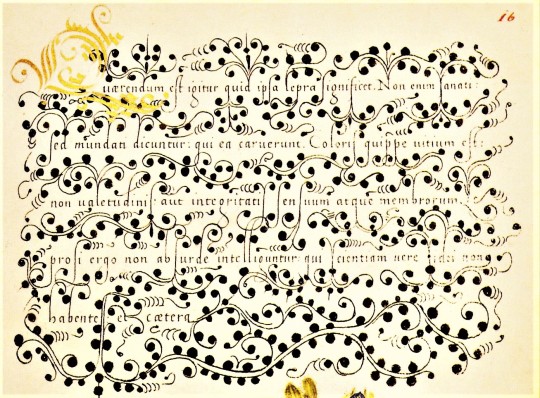

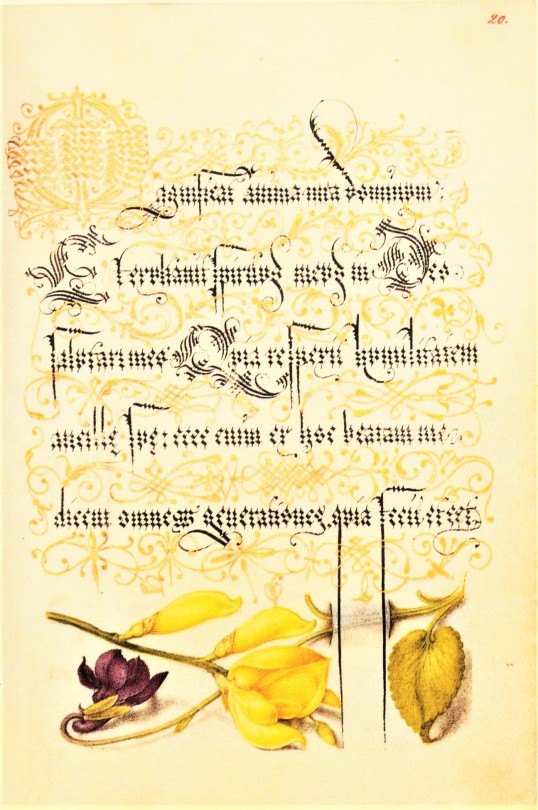


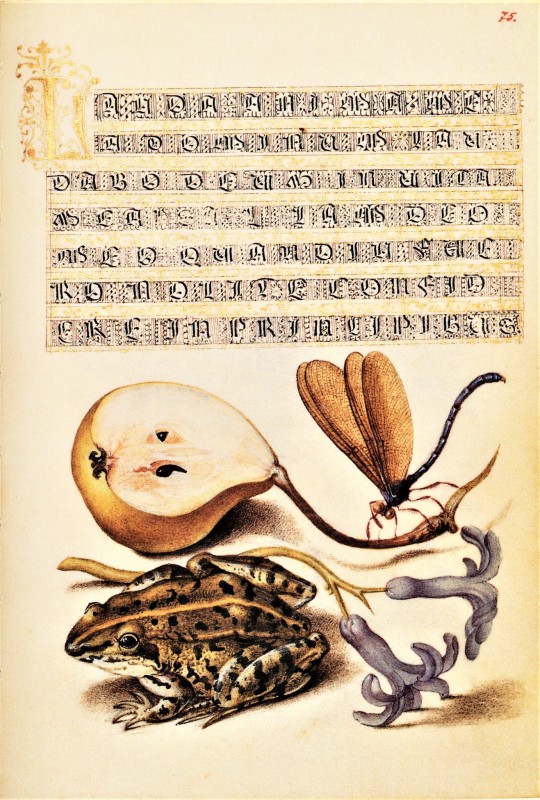



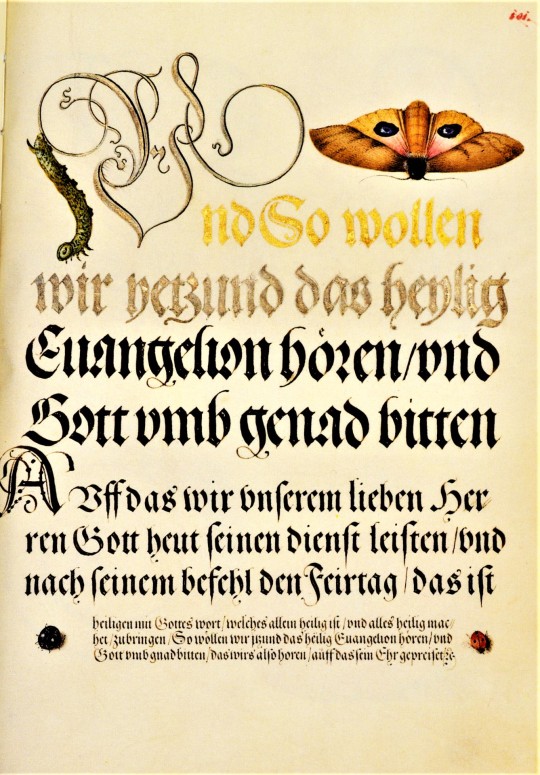

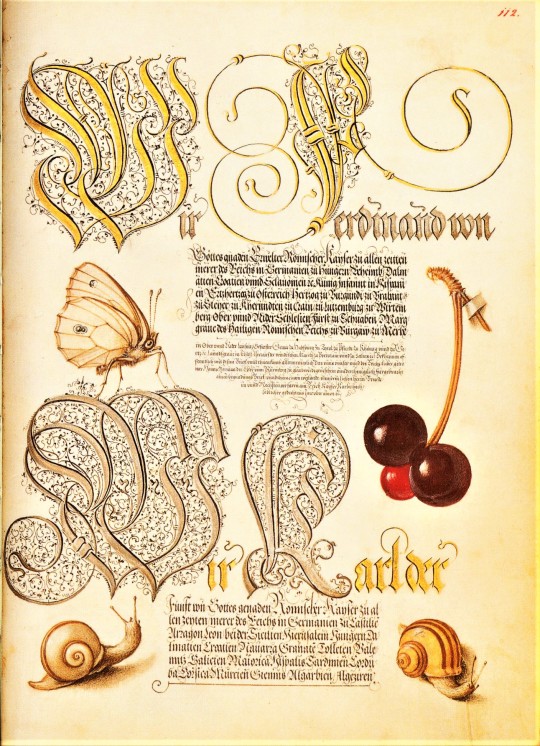
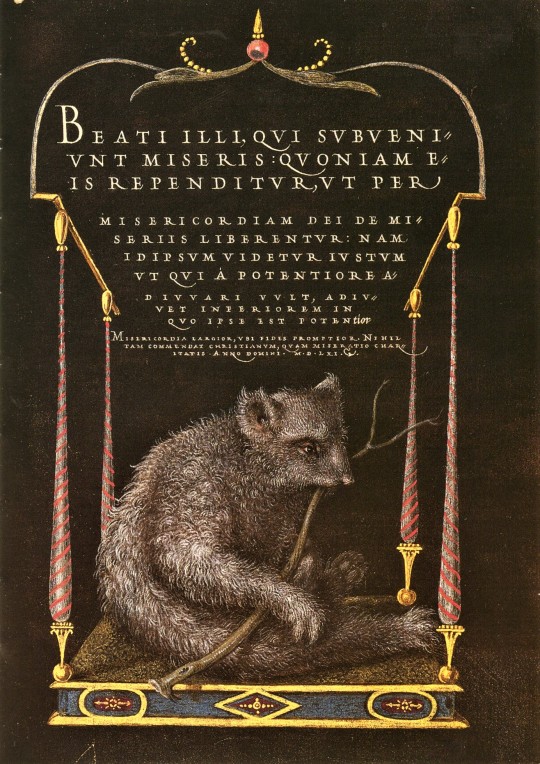
Typography Tuesday
We return to our facsimile of a 16th-cnetury calligraphic manuscript, Mira Calligraphiae Monumenta, or Model Book of Calligraphy, written in 1561/62 by Georg Bocskay, the Croatian-born court secretary to the Holy Roman Emperor Ferdinand I, and illuminated 30 years later by Flemish painter Joris Hoefnagel for the grandson of Ferdinand I, Emperor Rudolph II. The manuscript was produced by Bocskay in Vienna to demonstrate his technical mastery of the immense range of writing styles known to him. To complement and augment Bocskay's calligraphy, Hoefnagel added fruit, flowers, and insects to nearly every page, composing them so as to enhance the unity and balance of the page’s design. Although the two never met, the manuscript has an uncanny quality of collaboration about it.
Our facsimile was the first facsimile produced from the collection at the J. Paul Getty Museum in Los Angeles. It was printed in Lausanne, Switzerland by Imprimeries Reunies and published by Christopher Hudson in 1992.
View another post from Mira Calligraphiae Monumenta,
View more Typography Tuesday posts.
#Typography Tuesday#typetuesday#Mira Calligraphiae Monumenta#or Model Book of Calligraphy#Georg Bocskay#Joris Hoefnagel#illuminated manuscripts#manuscripts#manuscript facsimiles#facsimiles#calligraphy#letter forms#letters#J. Paul Getty Museum#Imprimeries Reunies#Christopher Hudson#Ferdinand I#Rudolph II
862 notes
·
View notes
Text
currently obsessed with olympic pictograms so i'm rating them
simplified images of different sporting events/locations helped athletes and tourists navigate the country even if they didn't speak the language, resulting in a win for accessibility and graphic design everywhere. below are a few notable sets.

^1. London, 1948: 5/10. aggressively old-timey, but i like the figure drawings
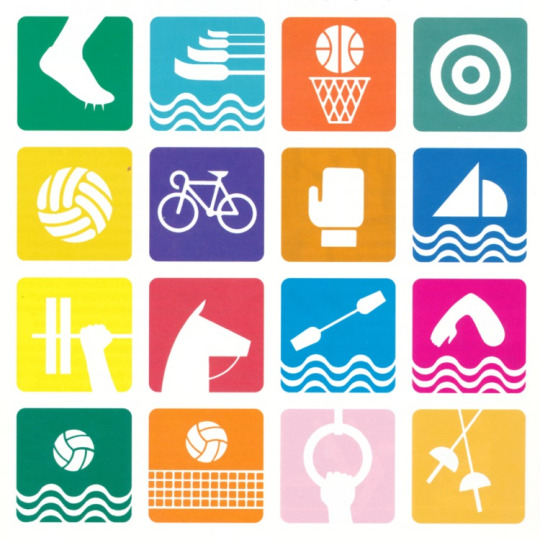
^2. Mexico City, 1968: 10/10 love the color choice, love the waves, love the weightlifing
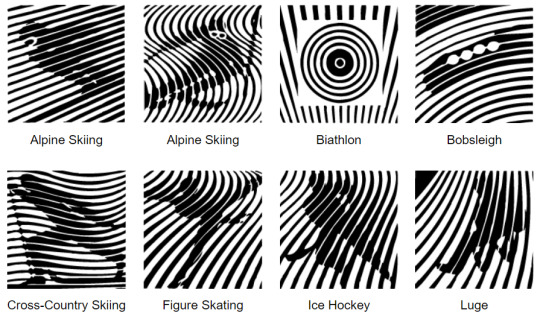
^3. Grenoble (winter), 1968: 9/10 a mild headache is worth it for the slay

^4. Munich, 1972: 4/10 not my favorite but set the precedent for future pictograms. the group shots are fun
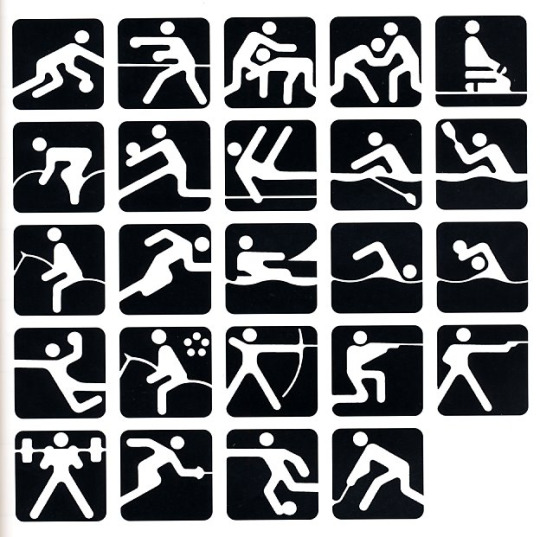
^5. Moscow, 1980: 6/10 munich plus wiggles :)
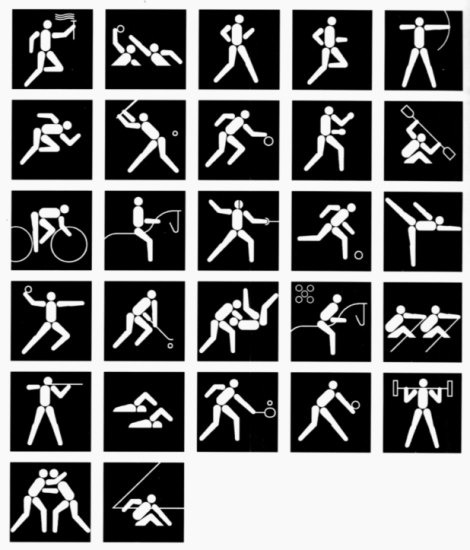
^6. Los Angeles, 1984: 4/10 they look like crash test dummies but points for good posture
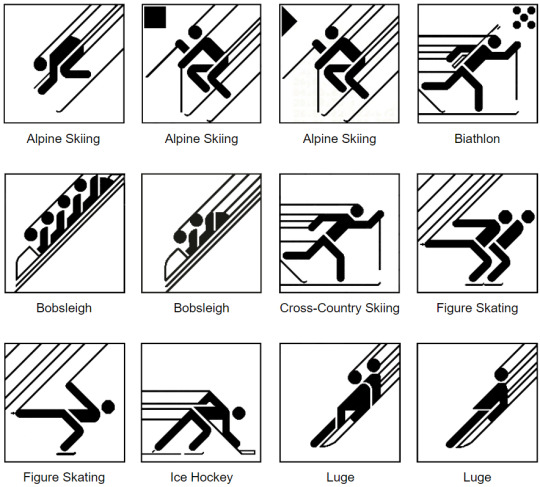
^7. Sarajevo (winter), 1984: 9/10 the additional lines give dynamism but don't distract from the central figures!!

^8. Barcelona, 1992: 7/10 i like the calligraphic influence
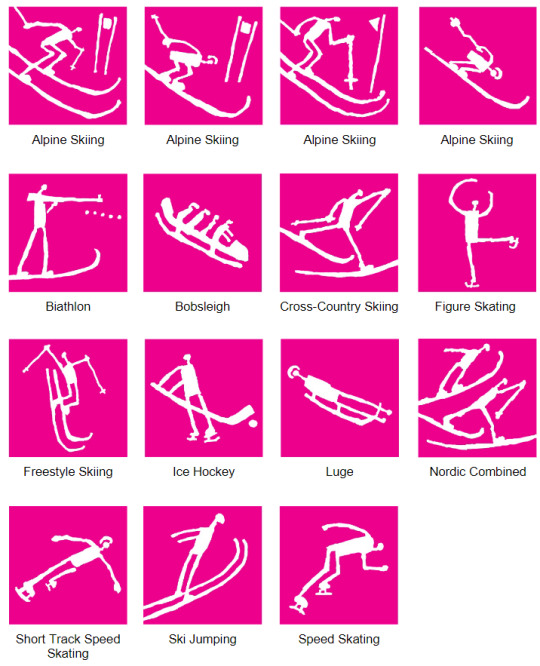
^9. Lillehammer (winter), 1994: 10000000/10 absolutely perfect little guys. actually it's one guy and he does all the sports
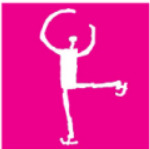

look at this shit it's delightful why did they keep changing pictograms after this when they obviously struck gold
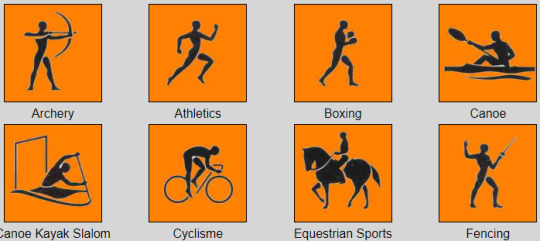
^10. Atlanta, 1996: 3/10 boring but points for being caked up
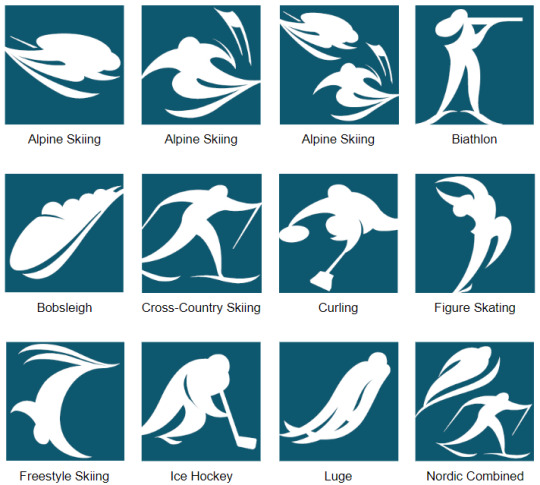
^11. Nagano (winter), 1998: 6/10 interesting paint-like strokes, deduction for luge which is actually a seeker of hermaeus mora come to kill me

^12. Sydney, 2000: 10/10 theyve all got little boomerangs :')
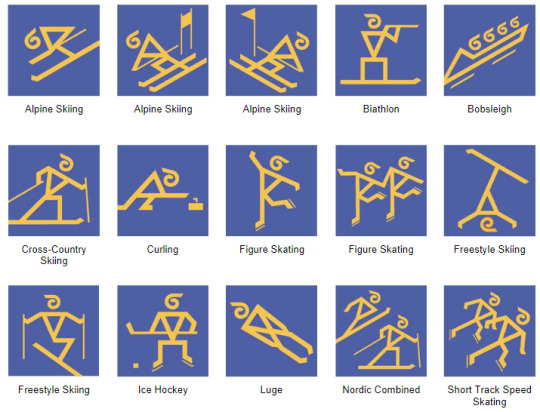
^13. Salt Lake City (winter), 2002: 5/10 based off cattle branding icons apparently? not my favorite but i have to respect the new direction
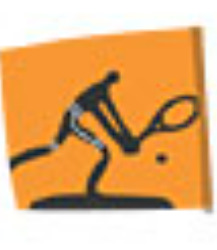


^14. Athens, 2004: 9/10 horrible cropping as to exclude their horrendous mascot but i love love LOVE when they take inspiration from the cultural history of a location!! in this case, cycladic figurines (pictured below)


^15. Turin (winter), 2006: 10/10 no notes i love it

^16. Beijing, 2008: 10/10 historical reference goes HARD
pictured: seal script, a predecessor to modern chinese lettering. you may recognize it from its use in avatar: the last airbender!
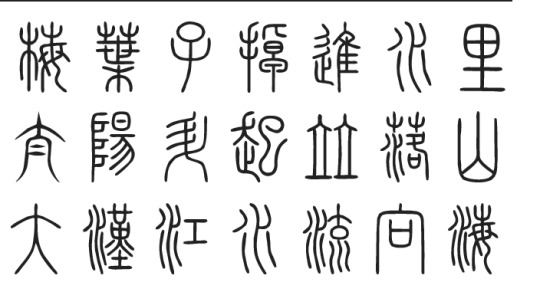
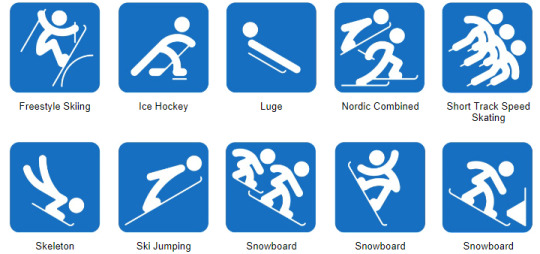
^17. Sochi (winter), 2014: 12/10 i love him he's just a fella. like that's my guy there he goes

^18. Beijing (winter), 2022: 8/10 i do like the calligraphic strokes but not as much as previous examples
HONORABLE MENTIONS
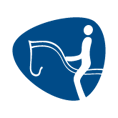

^equestrian events and kayaking at rio, 2016

^cycling at berlin, 1936 (all others were superimposed over the circle while this one fully incorporates it)

^biathlon at vancouver (winter), 2010: so fucking badass it's like a cartoon villain
Thank you for indulging my autism event :)
Links: Summer, Winter
12 notes
·
View notes
Text



“Earth Lament”, 2023, Pigment and pencil on Aquacryl on canvas and aluminium (and detail)


“So Far So Near”, 2024, Pigment and pencil on Aquacryl on canvas and aluminium (and detail)

“Cicada”, 2023, Pigment and pencil on Aquacryl on canvas and aluminium
Currently at Lisson Gallery is Shirazeh Houshiary: The Sound of One Hand, an exhibition of the artist’s new and recent work. For the paintings she combined distinct color formations with intricate patterns drawn on the surface using pencil. The details are astounding when seen up close.
From the press release-
For her first solo show in Los Angeles for over a decade, the British artist Shirazeh Houshiary presents new and recent works, exploring the origins of life and the mysteries of the cosmos, from a microscopic cellular level, to the stratospheric phenomenon of the aurora borealis. The show’s title relates to a Zen Buddhist teaching that instructs the student to listen to the sound of one hand clapping, in order to open their mind to such a possibility and transcend the constraints of the physical body. Despite not being a Zen practitioner, Houshiary realised that her work revolves around the insistent sound made by one of her hands, making tiny, looping, scratched marks in pencil onto large aluminum surfaces, building up worlds through the silence of her inscribed words.
Houshiary’s abstract paintings emerge from an initial pour of liquid color that floods the surface in irregular pools, before she then covers these areas with her own calligraphic gestures in graphite, which are in fact tiny repetitions of the Arabic phrases: “I am” and “I am not”, which she also likens to the natural act of inhaling and exhaling. For one of the two largest works in the show, entitled Enchanter (2024), Houshiary applies red pigment and pencil to a black ground in five ring shapes, recalling structures of carbon particles linked in a chain. Matching this in scale but cooler in tone, is the painting Earth Lament (2023), with two silhouetted blue figures that somehow materialized from the sedimented pigment, one appearing to soar and the other seemingly being dragged down. This accidental figuration also occurs in the work Cicada (2023), which could just as easily be a depiction of the wings of this insect as it could be a representation of its rhythmic song. At the other end of the scale are the galactic indigo swirls of So Far So Near (2024) and the bands of ethereal light crisscrossing the work titled Aurora (2023), recalling those seen occasionally streaking across a night sky.
Occupying the floor is a sculptural installation in nine parts, made from an open latticework of aluminum bricks in blue and green hues, each with the same footprint, but all at different heights, growing at increments of one layer at a time (the shortest has five layers, the highest thirteen). Entitled Maelstrom (2022), these curved forms, both hard and supple at the same time, recall not only the molecular structures of the red painting Enchanter, or “that primeval storm within the spiral of creation where something grows,” as the artist puts it, but also the shape of the ouroboros snake eating its own tail.
A second sculpture, seemingly another form defying logic and gravity, bursts from the wall. Its two sinuous, entangled lines are the artist’s approximation of the movement of a solitary wave – lending it the name Soliton (2024) – which is a type of swelling or surging motion that is not dependent on previous pulses, or followed by other waves. From such unfathomable objects, to minute molecules and gigantic expanses of space, Houshiary’s artworks represent a journey through everything from the chaos and messiness of the Big Bang to the silent contemplation of the resulting energies that surround every one of us.
This exhibition closes 11/2/24.
#Shirazeh Houshiary#Lisson Los Angeles#Art#Art Show#Art Shows#Cosmos#Drawing#Lisson#Lisson Gallery#Los Angeles Art Shows#One Hand Clapping#Painting#Sculpture
0 notes
Text
🔹
XVI əsrdə yaşamış Təbrizli miniatürçü rəssam Mir Seyid Əlinin öz görünümü (avtoporteti).
▫️
بودا بیزیم تَبداش "میر سید علی نقاشئن" اُوز گؤرونوْمو.
🔺
Mir Sayyid Ali (b. 1510). Self-Portrait of Mir Sayyid Ali, 1555-1556. In the collection of the Los Angeles County Museum of Art (Los Angeles County Museum of Art)
▫️
Mir Sayyid Ali was born in Tabriz, Azerbaijan-Iran. He migrated to Kabul, Afghanistan in 1552 to work for the Mughal Emperor Humayun (r. 1530-1540 and 1555-1556) and accompanied him to Delhi in 1555 to become the director of the royal manuscript atelier. He oversaw the production of the Hamzanama (Adventures of Hamza) project consisting of 1400 large-scale paintings bound in fourteen volumes in 1562-1572, which was completed under Abd al-Samad in 1572-1577 (see M.78.9.1). Mir Sayyid Ali depicts himself dressed in South Asian garb. He wears a Deccani style white turban with a decorative band wrapped around it and a floral jigha (plume-like ornament similar to an aigrette). Kneeling on a rug in a landscape, he is intently reading a book supported by an elegant book stand (see M.73.5.118 and M.76.2.19). Beside him is an inkwell, a pen box (see M.73.5.340 and M.89.160a-b), a writing tablet with two inscriptions, and an unfurling paper scroll. The upper inscription on the tablet reads, ‘At the top of the writing tablet, it is written in gold: “The master’s tyranny is better than the father’s kindness.”’ The lower inscription furnishes the artist’s signature, ‘Depicted by Sayyid Ali, the rarity of the kingdom of Humayun Shah.’ The calligraphic panels on the rug are a poetic couplet, ‘My two eyes are the coverings in that abode so that you may ordain your bridal room, there. Wherever you trudge along, I want to become the dust on the road, there.’ (Translations by A.S. Melikian-Chirvani.)


#azərbaycan#azerbaijan#tabriz#تبریز#Mir Sayyid Ali Tabrizi#Mir Seyid Əli#Nəqqaş#Rəssam#İran#los angeles county museum of art
1 note
·
View note
Text

Visual Art in Jewish and Native American Language Reclamation
Sunday June 2, 10-11:30am PT / 12-1:30pm CT / 1-2:30pm ET / 8-9:30pm Israel
Join the Jewish Language Project for a panel exploring the connection between visual art and the revitalization of endangered languages.
Panelists:
B.A. Van Sise, Author and photographic artist
Lokosh (Joshua D. Hinson), artist and Executive Officer, Division of Language Preservation, Chickasaw Nation
Ruben Shimonov, a calligraphic artist who highlights Bukharian, Persian, Arabic, and Hebrew
Dr. Sarah Bunin Benor, Director of the HUC-JIR Jewish Language Project
This panel is being presented in conjunction with B.A. Van Sise's latest exhibit, “On the National Language: The Poetry of America's Endangered Tongues.” This project was developed in consultation with dozens of indigenous nations, as well as both Native and diasporic cultural organizations. Among its many accolades is the 2024 Anthem Award for Diversity, Equity and Inclusion by the International Academy of Digital Arts & Sciences. Starting October 2024, "On the National Language" will be featured in a six-month solo exhibition at the Skirball Cultural Center in Los Angeles.
Register here.
1 note
·
View note
Text
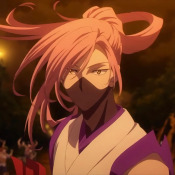
Name: Kaoru Sakurayashiki
Series: Sk8 The Infinity
Continuity: Anime
Age: 27
Height: 5'9"
Birthday: March 27th
Birthplace: Okinawa, Japan
Orientation: Homosexual
Species: Human
Occupation: Calligrapher, Skateboarder
Father: Gaku Sakurayashiki
Mother: Kayo Sakurayashiki (deceased)
Bio:
Born to a father that owned a small tech company and a quiet stay-at-home mom, Kaoru Sakurayashiki was pretty spoiled as a child. He was their only child, as he has no brothers or sisters to speak of, so it's safe to say that his parents wanted him to have the best life possible.
This meant that Kaoru ended up growing a sort of attachment and abandonment issue. The older he got, the more his parents started to take off. His father's tech company required more business trips to Tokyo while his mother had poor health and had to stay in bed most days.
He probably would've been completely alone had it not been for the only other child in the neighborhood, Kojiro Nanjo. He and Kojiro hit it off immediately and pretty much became inseparable friends, some even thought they might've been family from just how close they've been. Though some question how when they bicker and argue nearly every chance they get. It's all their way of bonding as friends though, though originally it was a lesson to tech Kaoru when they were kids about treating others better.
Due to being so spoiled, it made Kaoru arrogant in himself. With Kojiro being so down to earth, the two ended up balancing each other out and pulling the other up or down when they needed a hand to reach out for them.
This was especially needed when his mother passed away during his second year of high school from her poor health. He probably would've been a complete wreck, had it not been for Kojiro to introduce him to skateboarding where they'd sneak out their homes in the middle of the night to skateboard in the streets.
With his father still working in Tokyo full time, Kaoru started to rebel against him. He got a lip ring, sakura branch tattoo on his lower back and earrings to make his father mad, knowing he would disapproved of that kind of 'inappropriate' jewelry. He never did notice, only making Kaoru rely more on his new skating family and Kojiro.
One night they met a mysterious skater who went by Adam. The three of them quickly became a group of best friends. They're some of Kaoru's happiest moments, and the three of them decided to start a secret skating club called "S" where they could all be free. In S, they'd skate on dangerous tracks while trying to impress one another.
It was no wonder that Kaoru fell in love with Adam, and damn did he fall hard. Just before he was planning to confess to him about his feelings, Adam started behaving strangely.
Adam would try to pull skaters into "the zone", a state of mind when your brain goes on auto pilot which is pretty much suicidal on dangerous tracks. On top of that, just before graduation, Adam announced he's quitting skating and moving to America.
This left Kaoru heartbroken and deeply upset, he was practically ready to chase after him to America until Kojiro pulled him aside and stayed there for him. They did try to find him after graduation, but Kaoru couldn't dig up any information online about him. Why did Adam have to be so distrusting and cold to leave them like that?
Over the next ten years, Kaoru stayed in Okinawa to study in calligraphy. His father suggested he try studying tech and joining the business, but he declined despite his immense talent. As time went on, he discovered how much he loved writing. Skateboarding was fun, but writing traditionally really did calm him down and help process so much about his life.
After college, Kojiro and Kaoru stayed together like glue. They traveled around the world together, including France and Los Angeles. Yet Kaoru would never forget Adam, wondering just what the hell happened to him?
A few years ago, Adam mysteriously returned from America and reopened S. Every time they tried to talk to Adam or call out to him, he pretty much ignored them. Something was definitely wrong with him, Adam didn't look like the calm and happy teenager they knew. This was someone who was clearly miserable in their life. If anything, it reminded Kaoru of how bitter he felt as a teenager.
He would eventually get to skate alongside Adam in an attempt to get through to him, but he was met with a skateboard to the face and told he was 'boring'. Kaoru was absolutely furious at Adam, and any feelings he had for Adam was now gone.
This wasn't the Adam he knew as a teenager anymore. This was Adam going off the deep end as though to prove a point to someone. Who? Himself? He wouldn't really know.
It's only a few weeks after Langa faced off against Adam that he got those answers at a party to congratulate Langa for winning again him. Adam had apparently had a rough childhood and a suffocating private life, but it doesn't mean that Kaoru will forgive him right away for what he did to him and Reki or...ever really.
It all depends on how hard Adam tries to change as a person now that Langa has helped him move into a better direction in life. If he does? He'll think about it and be open to repairing their friendship. If he doesn't? He can't see himself being friends with Adam ever again. His only true friend is Kojiro, their relationship is true infinity.
Kaoru is very intelligent, calm, polite and kind hearted. Yet he's also easily jealous, stubborn, prickly, arrogant, childish and even a little selfish at times. He's also incredibly good with technology and has an AI assistant in his skateboard and cell phone named Carla. Carla's voice was designed after his mother, and he can only fall asleep if Carla sings the same lullaby his mother did. Horrifically prideful as he is, he still misses his mother dearly. Though he did work out his relationship with his father over time, Though his father still works in Tokyo.
He's extremely close with Kojiro, as much as they argue among one another, and he takes on a motherly role for the younger teenagers inside of S. He'll never admit it, but he wants to help guide the kids through that confusing period of life. His name in S is Cherry Blossom, a reference to his last name containing 'Sakura'.
1 note
·
View note
Text
Elevating Elegance South Bay Wedding Invitation Design and the Art of Calligraphy
In the realm of weddings, every detail contributes to the creation of a unique and memorable experience. From the enchanting venues to the delicate floral arrangements, each element weaves together to narrate a couple's love story. Two significant components that set the tone for the celebration are the wedding invitations and the calligraphy that adorns them. In the picturesque South Bay, a haven of artistic inspiration, couples find themselves entranced by the world of South Bay Wedding Invitation Design and the expertise of a South Bay Wedding Calligrapher.

Falling in Love with Letterforms
For many individuals, the fascination with letterforms and the art of calligraphy harkens back to cherished childhood memories. The joy of imitating various handwriting styles and signatures, particularly those of loved ones, often serves as the spark that ignites a lifelong passion. Gel pens, with their vivid hues, take us back to pencil cases teeming with creativity. It's the love for intricate details that fuels the fire, driving enthusiasts to achieve the perfect stroke and form.
A Journey Through Perfection
In the South Bay, where creative expression is nurtured and embraced, the world of wedding invitation design blossoms into a captivating realm of its own. South Bay Wedding Invitation Design is more than just a task; it's a journey of crafting pieces of art that reflect the essence of the couple's love story. Every curve, every flourish, and every choice of color comes together to evoke emotions and anticipation that resonate with the upcoming celebration.
The Masterful Touch of Calligraphy
Amidst this creative landscape, the role of a South Bay Wedding Calligrapher emerges as one of profound significance. Calligraphy is an ancient art form that infuses timeless elegance into every stroke. A South Bay Wedding Calligrapher possesses the ability to transform words into visual poetry, imparting a sense of grandeur and sophistication to wedding invitations. With a masterful touch, calligraphy brings personality and character to the cards, capturing the attention of recipients and leaving a lasting impression.
Crafting Memories with us
In the midst of South Bay's artistic tapestry lies a gem that captures the essence of South Bay Wedding Invitation Design and Calligraphy. LonaLee.com is a testament to the passion for letterforms and artistic expression. With a deep appreciation for the significance of weddings and the power of calligraphy, it offers a range of services that reflect creativity, precision, and a touch of magic. From wedding invitation design to the artful strokes of calligraphy, every creation is a masterpiece in its own right.
Conclusion
In the world of weddings, where emotions flow freely and love is celebrated, South Bay Wedding Invitation Design and the craftsmanship of a South Bay Wedding Calligrapher hold a special place. These elements go beyond the mundane; they are gateways to enchantment, conveying the essence of the couple's journey and setting the stage for an extraordinary celebration. As couples in the South Bay seek to infuse elegance into every detail, the magic of LonaLee.com adds an enchanting touch that elevates these cherished moments into unforgettable memories.
Our website contains all the information you need to know.
Custom Greeting Cards Los Angeles
Professional Calligrapher South Bay
0 notes
Photo

Truly.Madly.Ink (TMI) is a full service calligraphy and engraving company providing on-site services for all occasions. We offer lettering, monograms, quotes and other special designs. TMI is a full service sign shop specializing in metal, wood, acrylic and composite materials as well as vinyl banners and decals of any size in any shape or form.
Calligraphers Los Angeles
1 note
·
View note
Photo


A sombre black and red calligraphic image of the name Khodanoor, drawn to appear like a widely circulating photo of Khodanoor Lajali, a Baluchi man who tied to a flagpole and denied water by security forces and who was later killed during protests on Bloody Friday.
This photograph has since been reenacted by protestors inside and outside of Iran. The second image below shows how protesters handcuffed themselves to Chris Burden’s Urban Light at the Los Angeles County Museum of Art.
Source: Twitter/MahsaG26, The Art Newspaper
9 notes
·
View notes
Photo

Folio of Poetry From the Divan of Sultan Husayn Mirza, Sultan 'Ali Mashhadi, ca. 1490, Brooklyn Museum: Arts of the Islamic World
These four couplets of poetry in fine nasta'liq script were not written with a pen. Instead, the letters were meticulously cut from colored paper and pasted onto the dark blue paper. This technique, known as qit'a, or découpage, is used on this leaf and other leaves of this dispersed manuscript of the Divan (Anthology) of Sultan Husayn Mirza (r. 1470-1506). Although we do not have concrete proof, this page has been attributed to the great master of calligraphy Sultan 'Ali Mashhadi on technical and stylistic grounds (Welch 1979, 170). A great-great-grandson of Timur (r. 1370-1405), Sultan Husayn Mirza ruled over the northeastern Iranian province of Khorasan from 1470 until his death in 1506. He was not only a patron of the arts, but also a poet of considerable talent. Along with his closest friend, Mir 'Ali Shir Nava'i (1440-1501), also a poet of great distinction, he was responsible for establishing Chaghatay Turkish as a major literary language (ibid.). The verses on this folio, from a ghazal, or sonnet, composed by Sultan Husayn Mirza himself, have been translated from Chaghatay Turkish into English by Professor Wheeler M. Thackston: O Husayni, when I cast a glance at the fiery countenance, fire catches in my eyes from the blow of the pain of separation. In me there are a hundred entreaties every moment; in him/her is nothing but disdain. Every moment I die a hundred deaths; that beauty is unconcerned. Say not that in your mournful heart is the melancholy over his/her tress, for in my mad heart is that same melancholy. My religion and Islam have been lost to love's plunder. Say not that I have only become mad for him/her. The word for "melancholy" (sawda) in the lines above also means "blackness," which accords with the blackness of the beloved's tress of hair. Other folios of calligraphic découpage from this manuscript are found in the Sadruddin Aga Khan Collection, the Freer Gallery of Art, Washington, D.C., the Los Angeles County Museum of Art, and in an album made for the Ottoman Sultan Murad III (r. 1574-95) now in the National Library of Austria (Vienna, Österreichische Nationalbibliothek Cod. Mixt. 313). [By Maryam Ekhtiar, from "Journey Through Asia" catalogue] Size: 8 7/8 x 5 1/4 in. (22.5 x 13.3 cm) Medium: Ink, opaque watercolors, and gold on indigo blue ground, with découpage and gold-flecked border
https://www.brooklynmuseum.org/opencollection/objects/57526
32 notes
·
View notes
Text

Los Angeles calligraphy
Los Angeles Calligraphers is a leading calligraphy and lettering design studio in Los Angeles, California. We specialize in wedding invitation calligraphy, hand-lettering, custom typography logo design and more.
0 notes
Photo

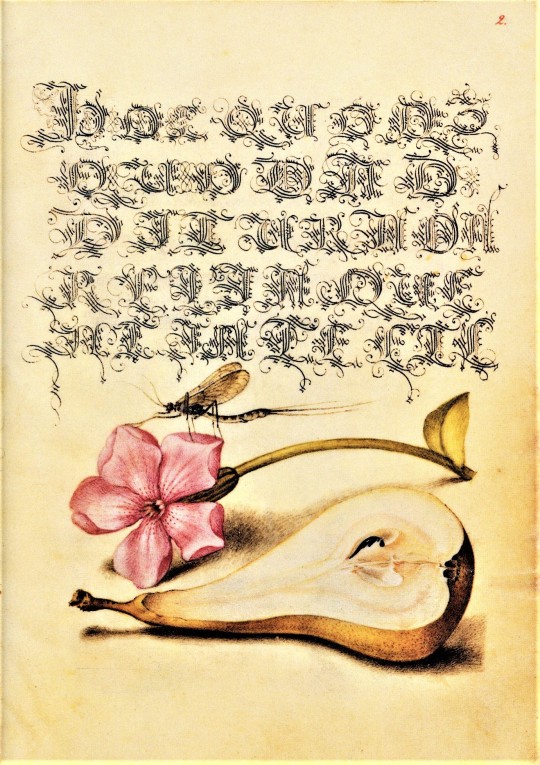
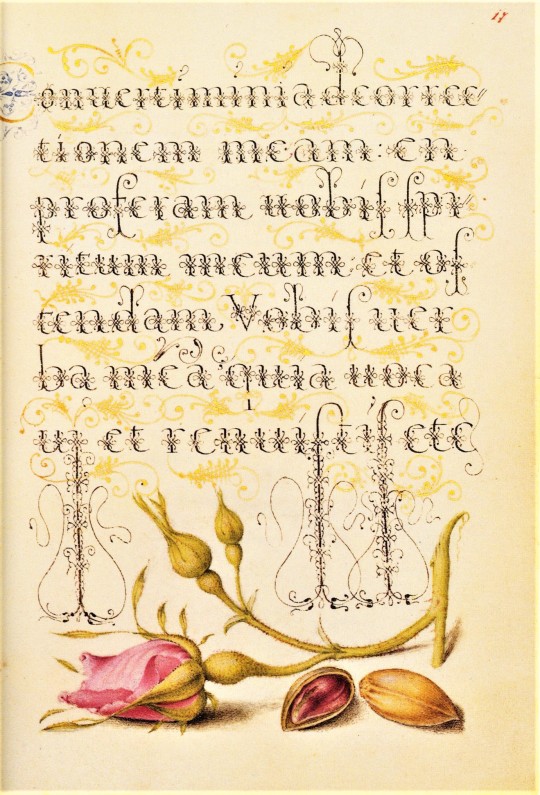




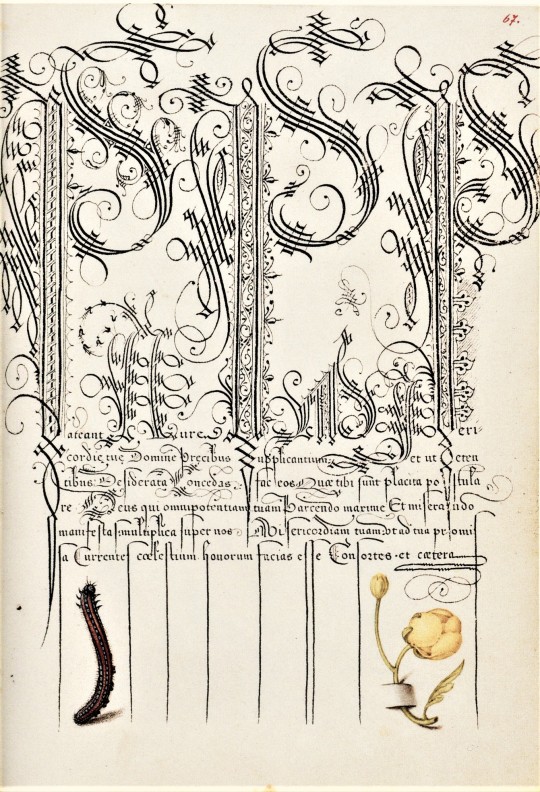

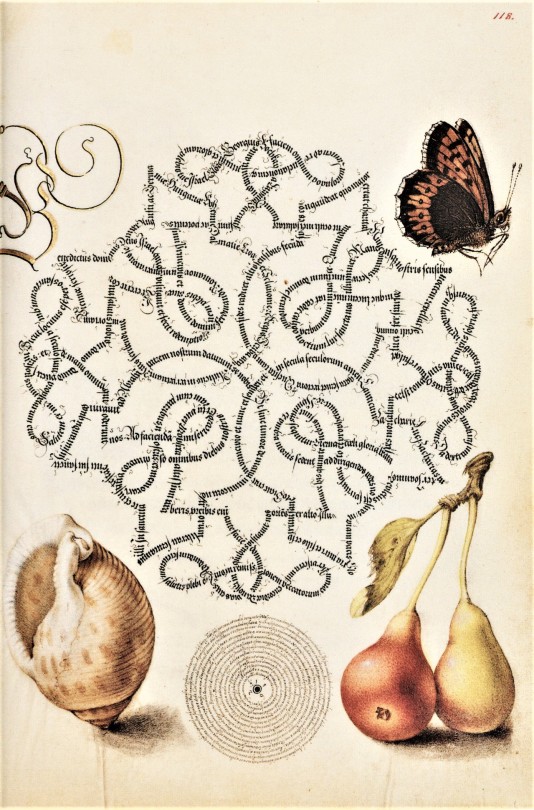
Typography Tuesday
Sometimes, things in our collection still surprise me, even after 29 years. From our fairly sizable manuscript facsimile collection, I was surprised I had never encountered this little (5 X 7 in.) reproduction of a 16th-cnetury calligraphic manuscript, Mira Calligraphiae Monumenta, the first facsimile produced from the collection at the J. Paul Getty Museum in Los Angeles, printed in Lausanne, Switzerland by Imprimeries Reunies and published by Christopher Hudson in 1992.
As the relatively new invention of printing came to dominate the production of books by the 1500s, the calligraphic inventiveness of scribes became prized for their aesthetic qualities rather than their production value.
From 1561 to 1562, Georg Bocskay, the Croatian-born court secretary to the Holy Roman Emperor Ferdinand I, created this Model Book of Calligraphy in Vienna to demonstrate his technical mastery of the immense range of writing styles known to him. About thirty years later, Emperor Rudolph II, Ferdinand's grandson, commissioned the [Flemish painter] Joris Hoefnagel to illuminate Bocskay's model book. Hoefnagel added fruit, flowers, and insects to nearly every page, composing them so as to enhance the unity and balance of the page's design. -- Getty Museum Collection webpage.
Although the two never met, the manuscript has an uncanny quality of collaboration about it.
Today we only show 11 pages from the facsimile, but we hope to present more from this highly-inventive manuscript of calligraphic virtuosity in the future.

View more Typography Tuesday posts.
-- MAX, Head, Special Collections
#Typography Tuesday#typetuesday#Typography Tuesday#Mira Calligraphiae Monumenta#Georg Bocskay#Joris Hoefnagel#calligraphy#letter forms#letters#J. Paul Getty Museum#Imprimeries Reunies#Christopher Hudson#illuminated manuscripts#facsimiles#manuscript facsimiles#Ferdinand I#Rudolph II
142 notes
·
View notes
Text
Why Meghan Markle Is a Champion for All Women
By Brittany Alexandra Sulc, updated on May 1, 2021
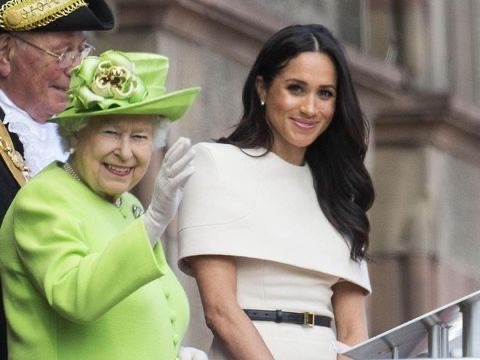
March is women’s history month, and the women of decades past deserve our celebration. Without them, we wouldn’t have the right to vote, own property or have a say in our own reproductive rights. The thing is, if that’s our bar for women’s liberation, it’s really low. The life of Meghan Markle is a perfect example.
This woman, who’s as close to a real-life, modern-day princess as a person can get, has been harassed, scrutinized and picked apart by the media and the royal family alike. In celebration of International Women’s Day, Meghan Markle’s bold moves are proof of how far we’ve come. Our treatment of her is proof of how far we have to go.
Meghan Markle is a new kind of royal, and not everyone’s a fan.
Let’s roll the tapes, shall we? Meghan Markle was born and raised in Los Angeles, California, and identifies as mixed-race. At age 11, Meghan confronted Procter & Gamble about a national dish soap campaign that she believed was sexist. A few months later, the company changed its ads.
She excelled in school, graduating from Northwestern in 2003 with a double major in theater and international studies. She went on to become an actress but met initial resistance because of her "ethnically ambiguous" looks. While she waited for her acting career to take off, she supported herself by teaching bookbinding and working as a freelance calligrapher. In 2011, she landed a lead role in USA’s "Suits," which she continued for several seasons through 2017.
She met Prince Harry in 2016, and the couple hit it off instantly. Less than two years later, they were married, and the following year, they welcomed their first child. At first glance, that sounds like every American girl’s dream. After growing up with Disney, "Princess Diaries" and the "Prince and Me," we all secretly loved the idea of being a princess. Meghan Markle lived out our dreams, but as it turns out, they weren’t as idyllic as we imagined.
In the five years since Meghan Markle met her prince, she has:
Struggled to gain acceptance from the royal family.
Been the target of harsh criticism and constant rumors from the British press and numerous tabloids. It got so bad that Prince Harry filed a defamation suit against one of them, which he recently won.
Had every detail of her past and personal life examined under a magnifying glass and exploited.
Faced significant backlash over her supposed choice to break with royal tradition.
Essentially, she dared to be American, middle-class, mixed-race, feminist and human. And she was punished for it.
Meghan Markle’s split from royal life was a symptom of a society stuck in the past. During Meghan’s time as an active member of the royal family, she faced a markedly different response from the media than her sister-in-law Kate Middleton. Meghan Markle’s previous divorce was picked apart, despite the fact that it happened years earlier. Something as innocuous as rubbing her pregnant belly, a pretty universal expecting-mom habit, was called "vain," while Kate was praised for doing the exact same thing.
Tabloids constantly portrayed Meghan as a rebellious villain set on breaking from tradition. In an 84-minute interview with Oprah, which was a scandal in and of itself, Meghan insists that couldn’t be further from the truth. She did her best to support the royal family, but they failed to return the favor.
When they had the opportunity to go on public record and deny slanderous rumors about her, they declined. In the interview, Meghan Markle stated, "They were willing to lie to protect other members of the family, but they weren’t willing to tell the truth to protect me and my husband."
When she appeared on the cover of almost every British tabloid, the royal institution asked her to lay low, despite the fact that she had left the house only twice in the previous months. It was all about appearances. Speaking of appearances, there was also a discussion about how her son would look when he was born. Specifically, whether his skin would be dark. Between blatant racist and sexist remarks to controlling isolation and a lack of support from "the firm," Meghan Markle’s mental health suffered. Whose wouldn’t?
In the 21st century, we’re still prioritizing appearances over mental health and human welfare. It needs to stop.
Meghan Markle endured all of this while pregnant, breastfeeding and adapting to motherhood. She went on to experience a miscarriage as well. Miscarriages are quite common, and they often happen without any apparent cause. Still, pregnancy is a physically taxing feat, and it’s possible for stress to impact a woman’s ability to sustain a healthy pregnancy. It’s insane that in 2021 we have cause to wonder whether the world stressed a so-called princess into a miscarriage.
How we treat people has a profound effect on their well-being. A modern-day "princess" felt so alone, so mistreated, that she didn’t want to be alive anymore. This is in her own words. She was so miserable that she didn’t feel like herself, experiencing terrifying, concrete thoughts about ending her own life. She felt trapped in a very similar way many of us felt during 2020’s lockdown, isolated and out of options. She sought help and was told no repeatedly because of how it might look, even when her life was at risk.
She attended an event in a beautiful, sparkling blue gown, because she did not trust herself to stay home alone. Harry clung to his wife’s hands in love and fear, while she cried every time the cameras turned away. The pictures show only her smiles.
Meghan Markle is the kind of princess we should all support.
To say that the situation was unacceptable was an understatement. It could easily be said that it was abusive. The dark, controlling nature of royal life was thick with racist overtones. The accusation that the couple abruptly left the royal family was, according to their interview with Oprah, entirely false. And we believe them. They left because, after two years of asking for help, they received none. Harry feared that he would lose his wife due to the toxic treatment by Britain’s oldest institution — much as he lost his mother Diana. The institution was more afraid of losing the favor of the tabloids than of losing the first person of color in their family to depression.
When the couple relocated to Canada, protections for them and their son Archie were cut off. Their location was already public knowledge, so they relied on Tyler Perry’s generous support to stay safe. When death threats are a common occurrence, safety is a pretty big consideration. They later moved to California, where they’ve spent the last year restarting their lives almost from scratch.
Meghan Markle entered the royal family with the intention of being a devoted part of it. There was no sinister plan to steal a prince from his royal lifestyle. Meghan and Harry left out of necessity. In many ways, it was an escape. Leaving simply wasn’t done, but they bravely did it anyway.
Love her or hate her, Meghan Markle deserves your respect.
She had no obligation to live the life Queen Elizabeth, the media, or anyone else expected of her.
In Markle's interview, she stated that during the wedding, her wedding, it didn’t feel like her day. It was a day for the world. The expectation was that she married a centuries-long institution, but she chose to, very simply, marry the man she loved instead. She’s now raising a beautiful family with him, passing on values they truly believe in. That’s a happily ever after we should support.
Whether or not Meghan Markle is a perfectly poised picture of royalty is irrelevant. She’s human, and it’s time we treat her like it. She elected to do what was right for her and her family despite scrutiny from the media and the royal family. Despite opposition from the literal queen.
It should not need to be said in 2021 that all women deserve respect, but apparently, it does. All women deserve respect, especially women like Meghan Markle. Meghan Markle represents us all. She represents the woman who wants privacy in the days after giving birth to her first child. The woman who gets upset with her sister-in-law, then has to defend herself against a twisted version of the story making national news. She represents the women whose health and happiness came second because of damaging stigmas. She represents the woman of color who doesn’t ever get a fair shot, no matter how hard they try to do everything "right."
Like her or not, every woman can see a part of herself in Meghan Markle. That’s why it’s so important to support each other. While the royal family didn’t speak out in support of Meghan Markle, 72 female members of British parliament did. We can only hope that the next time a beautiful, strong, intelligent woman of color joins Britain’s royal family, they think twice about how they treat her. Then, they treat her right.
35 notes
·
View notes
Text
Helen Frankenthaler at Gagosian Grosvenor Hill, London
May 18, 2021

IMAGINING LANDSCAPES Paintings by Helen Frankenthaler, 1952–1976
June 17–August 28, 2021 20 Grosvenor Hill, London __________ I had the landscape in my arms when I painted it. I had the landscapes in my mind and shoulder and wrist. —Helen Frankenthaler Gagosian is pleased to present Imagining Landscapes: Paintings by Helen Frankenthaler, 1952–1976, an exhibition of fourteen paintings from the collection of the Helen Frankenthaler Foundation, several of which have never been exhibited before. The references to landscape that are inherent in these paintings shift between subtle and explicit, as critic E. C. Goossen observed in 1958. All are characterized by an extraordinary variety of line and color. The earliest of them—painted in 1952, before Frankenthaler’s breakthrough development of soak-stain painting later that year with Mountains and Sea—is the work of an already mature artist: an invented panorama with suggestions of palm fronds and mountain peaks. The next belongs to a small group of canvases with drawn forms that Frankenthaler painted on her honeymoon with Robert Motherwell in the southwest of France. And four canvases from 1961—Fable, Beach Scene, Square Figure, and After Rubens—show her simplifying her drawing and making it more calligraphic, even as she continued to create figural as well as landscape references. In three canvases from 1963, a major change is evident in Frankenthaler’s approach. Juxtaposed areas of lush stained color replace the lines of the earlier paintings, their irregular borders evoking the boundaries of natural forms. The titles of these works—Narcissus, Yolk, Sea Goddess—invite interpretation of their sometimes aqueous, sometimes cloudy forms in the manner that Leonardo da Vinci advised painters to look at stained walls and see in them images of the natural world. Even as Pop art was recuperating explicit depiction, and Color Field painting purist abstraction, Frankenthaler maintained in her own way an art of allusion—the richness of ambiguous reference—and cultivated a complexity akin to the volatility of the physical universe.
In the imposingly large Cape Orange of 1964, Frankenthaler advances this approach with flatter, more opaque color to a bolder effect, suggesting a topographical map. And the pair of canvases from 1971, Orange Hem and Red Travels, simplify the effect further, evoking details of landscape seen from above—perhaps, the movement of water around an obstruction and a view into a cleft or onto a stretch of coastline, respectively. In both cases, the rectangle of the canvas substitutes for a framed view. The final two works in the exhibition, Chill Factor (1973) and Sphinx (1976), reintroduce earlier features to the format: the former with its meandering filaments of drawing and atmospheric color; the latter, a reprise of the bipartite structure of Narcissus (1963), with memories of the fluid, centralized composition of Mountains and Sea. A catalogue featuring a new essay by art historian Robert Slifkin along with three historical texts will be published to accompany the exhibition. In addition, a room of paintings by Frankenthaler is installed at Tate Modern, London, until November 2021. Helen Frankenthaler: Radical Beauty, the first major UK exhibition of Frankenthaler’s woodcut prints, will open at Dulwich Picture Gallery, London, on September 15, 2021. Helen Frankenthaler (1928–2011) is represented in major public and private collections worldwide. Her career has been the subject of three major monographs and numerous institutional exhibitions, including the Jewish Museum, New York (1960); Whitney Museum of American Art, New York (1969, traveled to Whitechapel Gallery, London; Orangerie Herrenhausen, Hannover, Germany; and Kongresshalle, Berlin); A Paintings Retrospective, Modern Art Museum of Fort Worth, TX (1989–90, traveled to Museum of Modern Art, New York; Los Angeles County Museum of Art; and Detroit Institute of Arts); Prints, National Gallery of Art, Washington, DC (1993, traveled to San Diego Museum of Fine Arts; Museum of Fine Arts, Boston; Contemporary Arts Center, Cincinnati; and Machida City Museum of Graphic Arts, Japan); Paintings on Paper (1949–2002), Museum of Contemporary Art, North Miami, FL (2004, traveled to Edinburgh Royal Scottish Academy, Scotland); Against the Grain: The Woodcuts of Helen Frankenthaler, National Gallery of Australia, Canberra (2005); Giving Up One’s Mark: Helen Frankenthaler in the 1960s and 1970s, Albright-Knox Art Gallery, Buffalo, NY (2014–15); Pittura/Panorama: Paintings by Helen Frankenthaler, 1952–1992, Museo di Palazzo Grimani, Venice (2019); Helen Frankenthaler Prints: Seven Types of Ambiguity, Princeton University Art Museum, NJ (2019); and Abstract Climates: Helen Frankenthaler in Provincetown, Parrish Art Museum, Water Mill, NY (2019, originated at Provincetown Art Association and Museum, MA, in 2018). _____ Helen Frankenthaler, Fable, 1961, oil and charcoal on unsized, unprimed canvas, 94 1/2 × 99 inches (240 × 251.5 cm) © 2021 Helen Frankenthaler Foundation, Inc./Artists Rights Society (ARS), New York
29 notes
·
View notes
Photo

In honor of World Calligraphy Day, here is a unique example of a calligraphic sketch created by King Hyojong (1619–1659), who was the seventeenth king of the Joseon Dynasty of Korea from 1649 to 1659.
“These calligraphic sketches were informal writings that King Hyojong wished to give to his daughter, Princess Sukan. These passages are written in standard, running, and cursive scripts. In the lower-left corner of the second page, for example, different versions of the cursive-script character guk, meaning ‘country’ or ‘nation,’ appear.” (pp. 196-197)
Hyojoing’s calligraphic style is graceful and seems very free in this informal writing style.
Beyond Line: The Art of Korean Writing brings a multidisciplinary approach to the history of Korean writing–from the earliest texts from the Three Kingdoms period to its use in contemporary art.
Beyond line : the art of Korean writing Edited by Stephen Little, Virginia Moon ; essays by Insoo Cho [and three others] ; additional contributions by Christina Gina Lee, Stephen Little, Natalie Mik, Audrey Min, Virginia Moon, Joon Hye Park, Eunsoo Yi. Los Angeles : Los Angeles County Museum of Art ; Munich ; New York : DelMonico Books·Prestel, 2019. 407 pages : illustrations (some color), maps ; 33 cm English “Published in conjunction with the exhibition Beyond Line: The Art of Korean Writing at the Los Angeles County Museum of Art, Los Angeles, California (June 16 through September 29, 2019)” HOLLIS number: 99153845075603941
#worldcaliligraphyday#calligraphy#korean writing#writing#harvardfineartslibrary#harvardfineartslib#fineartslibrary#Harvard#harvard library#HarvardLibrary
18 notes
·
View notes